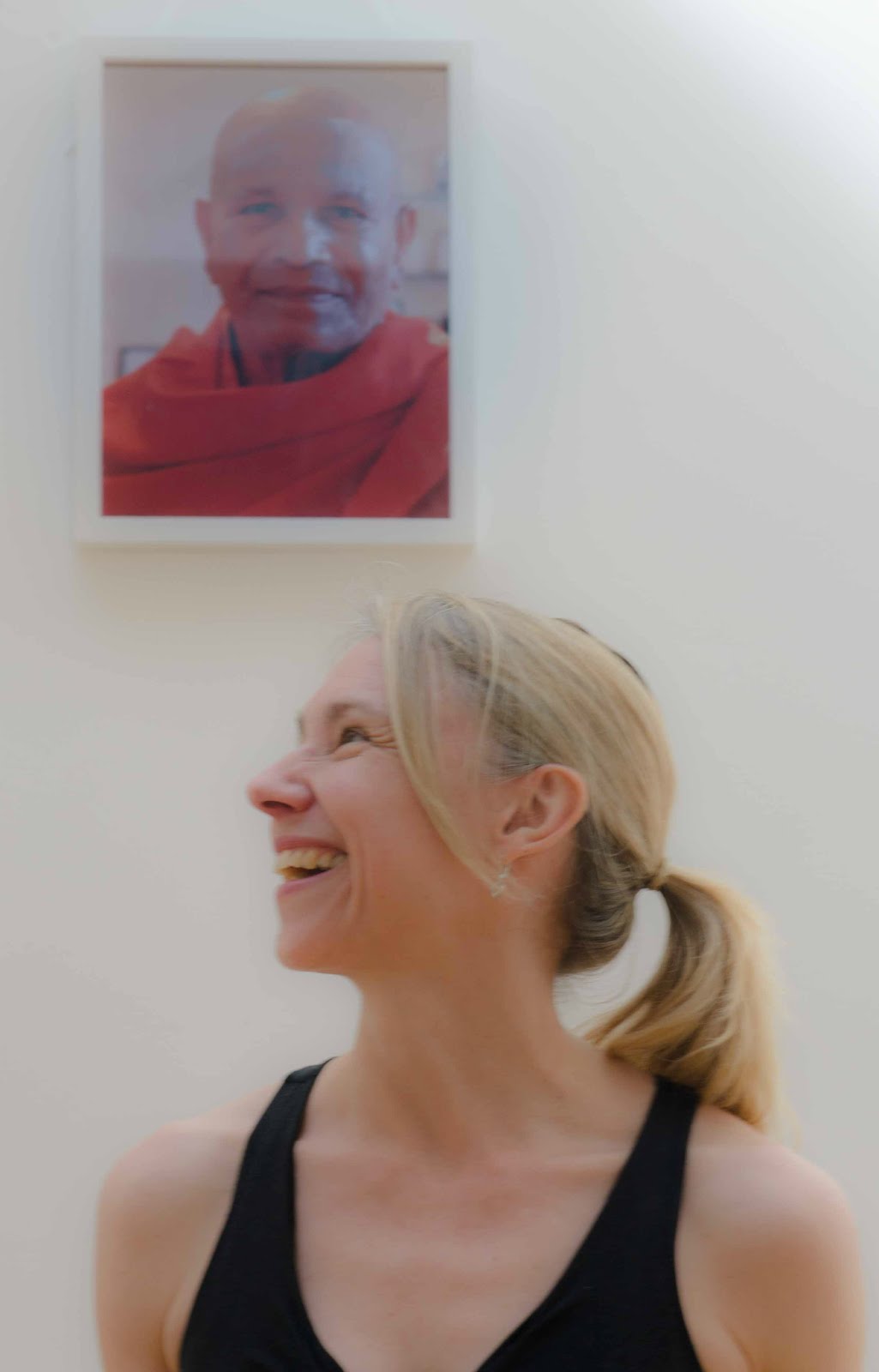Embarking on the path to share your yoga experience? There are more and more people doing yoga, which is amazing and I take it for a positive thing for human kind. However, at the same time ‘popularity’ can bring too many people offering yoga without enough experience and sincerity.
With the dozens of Teacher Training options available because of that ‘popularity’, it can be confusing for some to choose where to start. This whole ‘business’ of yoga has gotten out of hand in the last 10 years of so. But hopefully it is a sign that we are all closer to enlightenment than ever before! 🙂
My Story – When I started to teach Ashtanga…

In March 2002 I taught my first official yoga class. I had been practicing yoga since 1995 but only seriously practicing Ashtanga for just about 6 years. During that time I did yoga asana 5-6 times a week for 2 hours a day. In addition I read about yoga and Buddhist philosophy almost every evening and did a short meditation on the readings. I was doing my best to incorporate yoga into my daily living: Reflecting on the way I lived my life, the way I related with others, how my choices affected me, others and the planet…making the step-by-step changes that I was capable of.
Yoga had transformed me and gradually I was feeling less nourished and connected to the fashion world I was in. I had a deep feeling that I needed to share this yoga with others who are suffering in their human body/mind like myself.
I loved learning (still do) so I studied anatomy, the yoga sutras, a bit of Sanskrit (which I’m still horrible at) and whatever else I found interesting and relating to yoga. In 2002 the only teacher training I knew about was by the Sivananda School of Yoga. I looked into it and considered it but opted instead to stick to going to Mysore and travelling to study with long-time experience Ashtanga teachers and of course my teachers!
Over the years I’ve ended up doing a 200 hour Teacher Training with Ron Reid, Marla Meenakshi and Diane Bruni, and advanced TT with Ron & Marla, a couple of TT intensives with them as well, a TT intensive with David Swenson, another with Darby and a yoga anatomy TT, 3 philosophy trainings, a pranayama TT and several workshops and retreats, especially with my teachers but with others as well.
What I missed in my early years of teaching was the ability to help and understand those with very different bodies and capabilities than myself. It was easy to teach a relatively young, flexible, healthy person but harder to know how to help a tight, middle-aged person with aches from previous injuries. This is one of the aspects that is really important in a formal Teacher Training…you learn how to respect, appreciate and teach to others! People who may have different gifts than you. May have struggles that you cannot see on the mat (abusive relationships – past or present, self-hatred, bulimia, a lot of family responsibilities and dozens of other scenarios). People who have just different body structures or concentration skills. How can we honor the differences while sharing a structured path? This is the core of being a good yoga teacher and this is what a good Teacher Training will teach you!

How can we honor the differences while sharing a structured path?
A good yoga teacher is not necessarily someone who can perform complicated and advanced yoga asanas one after another. Success in yoga has nothing to do with getting your face in a yoga magazine, being liked by many, or becoming a yoga ‘personality’. In fact, one could argue that it is the antithesis of yoga! But that’s a consequent of what is called avidyā (ignorance) in yoga – we see a beautiful or cool person who speaks smooth, sweet words and seems to be the living dream of something we want to be a part of. So we make those people more ‘special’ and end up following the wrong path to happiness. Same on the yoga teacher side – we think that if a lot of people know us and like us that we will ‘be’ somebody and this will bring us happiness – forgetting all along that we will only find true happiness within. Forgetting that finding peace within is true success in yoga, simply beingrather than being this extra special person, in fact, seeing the sameness in all!
Success in yoga is simply BEING rather than being this or that.
It’s so hard to stay sincere and not lose sight of the goal. Our senses pull us to the outer world. They don’t naturally bring us within or help us see ourselves clearly. Their role is to bring us towards the things we need to survive and make us go away from the things that can harm the prospect of survival. But the problem is with modern society the senses are all confused. Most of us live with sensory overload. They can’t tell us with wisdom what is truly good or harmful for us. Therefore, without the wisdom of the higher mind the senses will mistakenly lead us in the wrong directions. For instance leading us towards fame and fortune rather than peace and equanimity. Without wisdom we won’t be able to see the subtleness of our motivations and desires.
This is why we have yoga practices. Techniques meant to teach us to see ourselves as we really are – techniques that should lead us to health in the body and mind – help us remove impurities so we see clearly and can make decisions for ourselves from a place of truth.
As a teacher, we don’t want to encourage people putting us on a higher pedestal than others – we want to encourage people to see us as people with some experience and knowledge to share with humility. Also, it is important that a teacher encourages us to use the teachings to think for ourselves. To go inside and see what is best for us. We don’t want to be needy children we want to be informed adults who can use the techniques of yoga as mirrors of observation to better know ourselves.
Our teacher will encourage us to make decisions about our practice that are nonharming, healing, energizing and empowering while working towards integration of the ego, humility and a calm peaceful mind.
Who gives you permission to teach yoga? I often get questions such as…after I finish the training will I be able to teaching? …is your training officially recognized? Both these questions are awkward to answer – the first because technically anyone can teach yoga. There are no governmental bodies prohibiting anyone to call themselves a yoga teacher or give public classes unless a certain license or diploma is obtained. Pretty much the yoga business is self-regulated. Which leads to the 2nd common question of our training being officially recognized. I guess because of the lack of recognition there have been a few people who have elected themselves authorities. Funny that most of the yoga “Federations” in France are run by yoga teachers or schools who give teacher trainings and of course, recognize themselves as being fit to teach and authorize others to teach.

Our teacher will encourage us to make decisions about our practice that are nonharming, healing, energizing and empowering.
However, the most well-known is the American based, internationally know Yoga Alliance. Honestly I’m not sure of the original intentions of YA. I think it was the reaction of people in the business realizing that some regulation was needed because anyone and everyone were deciding to be yoga teachers. (Gerald and I were approached by a couple that wanted to give classes at AYP who had started teaching after a 2-week retreat that “changed their lives”! Being from marketing and business backgrounds they’ve managed to accumulate a massive following – but not at AYP! )
Yoga Alliance has very basic standards of qualification and if one can prove to possess the qualifications one becomes a Registered Yoga Teacher. And, if you run a TT program based on their recommendations then you can become a “Registered Yoga School”. Gerald and I are both “Experienced 500 hour Registered Teachers” and AYP is a “Registered School able to give 200 hour and 500 hour teacher trainings”. We pay our dues to YA of something like 600 euros a year just to be able to make some people feel more comfortable that we are “Internationally Recognized”.
Sorry to say this for those who love little stamps of recognition… but it is a farce. J Yoga Alliance never checks up on the schools – I know many programs don’t even follow the recommended hours of anatomy or philosophy, for example. And, honestly even if YA tried to check up, who would do it? Each school of yoga has its own principles and even within the different schools some base more attention on different things.
It seems there is little emphasis on the number of years a teacher trainer should have been practicing and teaching to get their training recognized by YA. And once you pay the fees there are very few services given – besides some advice on how to use social media to get yoga students. Anyway, we keep paying to this huge organization feeling trapped.
So, if the stamp of recognition isn’t the benchmark for choosing a Teacher Training program, what is?
I’d say first do a Teacher Training with the yoga school you regularly practice at. If not, then investigate… how long have the teachers been practicing and teaching? How long has the TT program been running? Does the school and the teachers at the school have a good reputation? Does the program emphasis giving the trainee the foundations essential for learning the techniques in a safe, holistic environment? Does the program include anatomy and philosophy of yoga? Is there testing and evaluation? Do the teachers seem kind and generous? Does the program seem organized and professional? Those are some examples to start with.
I hope this article brings some light to the prospective yoga teacher, giving ideas to consider and investigate into themselves, their motivations and deepest desires.
Namaste,
Linda



